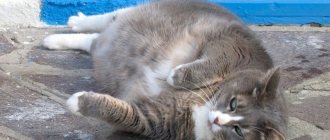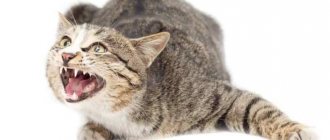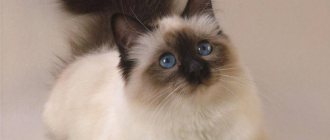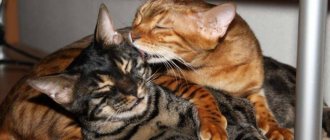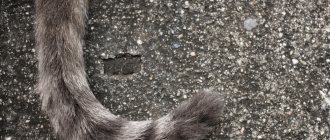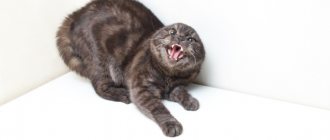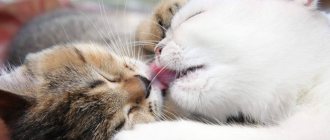Cats, like any other animals, do not speak human speech. They do not know how to “complain” and ask for help. Therefore, the owner must know what signs indicate a change in the pet’s health in order to provide him with the necessary help in a timely manner.
Let's find out how to understand that a cat is sick, and what symptoms require consultation with a veterinarian.
How to understand that a cat is sick
In fact, for an experienced and attentive owner this issue is not a problem. But if experience in keeping cats is minimal, then help in “recognizing” the disease is necessary.
You can tell if your cat is sick by the following signs:
- unusual behavior for one to several days;
- desire for privacy - the cat sleeps more often than it is awake;
- unnatural posture;
- decreased activity (mood), appetite;
- “grumpiness”, sometimes – a manifestation of aggression in response to an attempt at contact;
- the desire to lick the area of the body where there is pain;
- sometimes the cat begins to meow more often than usual or in some other way;
- sometimes you may notice shortness of breath, coughing, wheezing or other changes in breathing;
- the coat becomes drier and looks “ragged”, and the skin loses its elasticity;
- possible signs of gastrointestinal distress - diarrhea and/or vomiting;
- weight change;
- thirst due to food refusal;
- visible discharge from the nose and eyes;
- changes in the processes of urination and bowel movements - the color, smell, consistency of urine and feces may change, pain may appear when excreting urine and bowel movements;
- unpleasant odor from the skin, mouth, ears;
- discharge from the genitals;
- the appearance of swelling, lameness, stiffness of movement;
- noticeable increase in abdominal volume;
- sudden fainting, paralysis, loss of orientation in space;
- fear of water and/or light;
- salivation.
Important! In order to assume that a cat is unhealthy, it is not at all necessary to wait for all the listed signs of illness to appear. Even the presence of one of them is enough to create a motive to take the cat for examination to the veterinarian, because when a cat is in pain, the whole body suffers, and not just a separate part of it.
Emergencies.
Certain situations require IMMEDIATE action. You should immediately go to or call a veterinarian when any of the following happens to your cat. In this case, keep information about the veterinarians closest to you at hand, in case you need urgent specialist help.
- Trauma (such as falling from a height or being hit by a car)
- Labored breathing
- Gums become blue, white, or very pale
- Labored breathing
- Collapse, loss of consciousness
- Seizure
- Dizziness
- Loss of ability to walk
- Heavy bleeding
- Exposure to a toxic substance
- Severe pain (as indicated by, for example, loud screaming or aggressive behavior when touched)
- High body temperature
If you notice something that bothers your cat, remember better to play it safe. At a minimum, you can call your veterinarian for advice.
Cat pose when sick
A healthy cat behaves freely - walks, runs, jumps, lies, sits. A sick pet tries to behave as usual, but experiences pain or discomfort.
These sensations force the sick cat to take the body position in which discomfort and pain are least noticeable. This position is not always unnatural, but when a cat is in pain, the animal has a constant need to take just such a position.
Sometimes the disease manifests itself differently. For example, at elevated temperatures, a cat tries to retire, hide, so as not to be disturbed. He lies down with his front paws tucked under him and “ruffles up.”
But for both options it is typical that the cat is in a state of tension. This is evidenced by the cat's arched (hunched) back and belly, tucked in the direction of the spine.
Obesity
Often, owners, in pursuit of providing their pet with a better quality of life, offer excessive amounts of food. The result of this is the accumulation of excess fat mass and even clinical obesity of the animal.
And although excess body weight in itself is not so terrible, it can significantly complicate the life of a pet. The fact is that the growth of adipose tissue gradually leads to changes in hormonal levels, increased stress on joints and ligaments, the cardiovascular system, and a decrease in physical endurance. Obese cats have an increased risk of developing diabetes.
In addition to the above, in overweight cats, in the event of sudden starvation (more than 2 days), the risk of developing liver lipidosis, a serious disease that can be fatal, increases many times over.
Treatment and prevention of this pathology in cats consists mainly of providing the animal with a balanced diet, the calorie content not exceeding its daily needs. Among Purina® PRO PLAN® daily foods, diets with the Optilight® complex are used to prevent the development of obesity, with reduced calorie content, but at the same time a fully balanced composition, rich in protein and fiber.
Vocalization is one of the signs of disease in cats
Vocalization (loud, inviting meow) can be physiological or pathological. Physiological occurs when the cat demands food, meets the owner, and so on. Pathological vocalization indicates the presence of health problems in the animal.
If your cat constantly meows loudly, this may indicate the development of the following diseases:
- hypertension;
- hyperthyroidism;
- diseases of the central nervous system;
- the presence of malignant tumors;
- arthritis;
- pathologies of the urinary tract;
- diseases of the digestive system.
Vocalization is also often observed in older animals. In cats, just like in humans, hearing and vision decrease, animals become more irritable and sensitive.
Features of using the tray
If a cat begins to relieve itself in inappropriate places, then the owner should be wary. This may be a signal that the animal is unwell. You need to observe the nature of the bowel movements.
You should contact your veterinarian if:
- loose stools;
- there is blood or mucus in the discharge;
- frequent urination;
- the urine becomes thick, dark and has an unpleasant odor.
The above signs may indicate diseases of the urinary system or gastrointestinal tract.
Behavior
Behavior in cats can vary depending on the type of disease, but it is always the earliest symptom of any feline disease. Whatever the normal behavior, in a sick cat it will always be different from usual.
For example, with elevated temperature, intoxication, or internal bleeding, the cat will be lethargic, indifferent, and will try to distance itself from any contact. And with carnivore rabies, which affects the nervous system, the cat is likely to be agitated, even aggressive, then overly affectionate, and later paralyzed.
Important! If there are obvious injuries, the cat will try to leave to avoid inspection and any manipulation. It is especially important to remember this if hidden injuries are suspected.
Body temperature in cats
Normal body temperature in cats is 38-39 degrees. The larger the animal, the closer its temperature is to the lower limit of normal. So for a kitten the normal temperature will be 38.5-39 degrees, and for an adult large cat – 38-38.5.
Depending on the disease, the cat’s temperature may decrease or increase, but it is impossible to establish a diagnosis based on this sign alone. Both hyperthermia and hypothermia are dangerous conditions for cats.
Also, at elevated temperatures, the cat's ears, paws, and nose may be hot, but this is not necessary.
To measure temperature, you can use a regular medical thermometer and any neutral lubricant (most often Vaseline or Vaseline oil).
The procedure is as follows:
- The thermometer is shaken (or reset if the device is electronic).
- The tip of the thermometer is lubricated and carefully inserted into the cat's anus about 1.5 cm.
- After measuring the temperature, the thermometer is thoroughly wiped with a cloth soaked in a disinfectant solution.
- The device must be stored in the protective case provided by the manufacturer.
Important! Taking temperature is an unpleasant procedure for most animals. In order for a sick cat to experience minimal discomfort during such manipulations, you need to fix it, talk to it calmly and lightly massage the area of the base of the tail from above, from the back.
Character of bowel movements
In order to notice changes in the nature of feces and urine, you need to know what they should be normally in a cat. Feces may vary slightly in consistency and color (depending on the type of feeding). But in any case, feces should be formed, the color should be from light brown to dark brown, without a strong odor.
In sick cats, the stool may be too loose (diarrhea) or too dry (dehydration, constipation), and the color may range from light gray to black. The smell of feces in some diseases can be extremely unpleasant and very pungent.
A cat’s urine should normally be transparent, yellow, with a specific odor, without foreign inclusions (traces of blood, “sand”, etc.).
Viral diseases
Most viral diseases can be effectively prevented through vaccination. Among the most dangerous are rabies, infectious panleukopenia (feline distemper), coronaviruses and calcivirosis. In some cases, these diseases can quickly kill a pet. Many viral diseases are characterized by fever, vomiting, diarrhea, and ulceration. Infection usually occurs through contact with a sick animal. Antiviral drugs and serums are used for treatment, but their effectiveness depends on the type and stage of the disease.
Among the personality traits that are completely normal for healthy domestic cats, scientists from Liverpool John Moores University identified boldness, lack of restraint and a lack of empathy. According to experts, these traits were useful for the ancestors of domestic pets in terms of acquiring resources - such as food, territory and mating opportunities.
Respiratory rate, shortness of breath, cough – manifestations of the disease in cats
A healthy adult cat makes 20-30 respiratory movements per minute, and kittens - 30-50. Respiratory rate is affected not only by diseases, but also by environmental parameters. In the heat, the number of inhalations and exhalations can increase by 1.5 times, in the cold it decreases to the lower limit of normal.
The nature of breathing movements may also vary. Normally they are medium-deep and smooth. During sleep, a cat's breathing can be rare and deep, but in critical conditions, breathing becomes shallow - “fast” and intermittent.
Rapid, infrequent (if there are no adequate reasons for it) or shallow breathing most often indicates the development of the disease in the animal.
In order to find out the respiratory rate of a sick cat, you need to time it and count the number of inhalations and exhalations in 30 seconds, then multiply the resulting value by 2.
Discharges and discharges in diseases in cats
Symptoms of some diseases include discharge from the eyes/nose/genitals. Discharge is the release of purulent, catarrhal (mucous), catarrhal-purulent, hemorrhagic (with blood) exudate.
Normally, cats can discharge only from the genitals and only in two cases - during estrus or during pregnancy. But such discharge should not be mixed with pus and should not have an unpleasant, putrid odor. The cat may have slight discharge from the prepuce (remnants of smegma or lubricant).
There should be no discharge and/or discharge from the eyes and nose, therefore, if any appear, this is a sign of the disease.
Condition of coat and skin
A healthy cat has elastic, smooth skin (without foreign formations, swelling and wounds), toned muscles, smooth, shiny, not disheveled fur (the hairs adhere well to each other), without bald patches and dandruff, without ectoparasites and traces of their vital activity.
If the skin of an adult cat or kitten does not meet these requirements, then there is a high probability of developing pathology. Very often, skin changes (local lesions or systemic damage) are a sign of some deeper and more serious disease.
In this case, consultation with a veterinarian is required to make a correct diagnosis and further treatment.
Condition of the eyes and mouth in a sick cat
The conjunctiva (mucous membrane of the eye) and the cat’s mouth should be clean, moderately moisturized, and without defects.
There should also be no visible defects (wounds, ulcers) in the pet’s mouth. The number of teeth is according to age standards. They should be smooth, tightly adjacent to each other, without tartar. There should be no unpleasant odor coming from the cat's mouth.
You should also pay attention to the amount of saliva and the condition of the oral mucosa. It should be smooth and moderately moisturized.
What symptoms require immediate medical attention?
All diseases have certain symptom complexes. Therefore, if a cat exhibits one of the signs, there is no need to urgently contact a veterinarian. You can postpone your visit to the clinic for a while and observe your pet. But cats are animals with a fast metabolism, so many diseases, often of infectious etiology (origin), develop quickly in them.
Such cat diseases require immediate medical attention and are characterized by the following signs:
- significant (often persistent) changes in body temperature;
- persistent vomiting and/or diarrhea;
- dehydration;
- intoxication (weakness, lethargy, apathy, lack of appetite);
- neurological abnormalities (disorientation, fainting, paralysis/semi-paralysis);
- blood in urine and/or feces;
- purulent, hemorrhagic discharge from the nose, eyes, genitals;
- eye and head injuries;
- “overgrown” third eyelid;
- extensive wounds or other damage to the skin;
- excessive salivation;
- bloating;
- difficulty breathing, cough;
- itching and/or foul odor in the ears;
- heavy bleeding of various origins.
Expert opinion
Chepa Natalya Semenovna
Veterinarian
Ask an expert
Please note that a drop in temperature to 37.5 or below is dangerous for the animal’s life and requires immediate contact to the clinic. Frequent vomiting and diarrhea are very life-threatening for a cat, especially for small kittens that quickly become dehydrated. Do not hesitate to visit if you have a problem with urination. This applies to a greater extent to males. If a cat sits on the tray frequently, but to no avail, for more than a day, he will need immediate veterinary attention. One of the common problems in cats is constipation. Absence of bowel movements combined with vomiting is a reason to contact the clinic as soon as possible.
Parasitic diseases
Cats are susceptible to fleas, lice eaters, ear mites and various types of helminths. You should not think that an animal that does not go outside is completely protected from parasites - eggs of helminths and fleas can easily be brought into the house on the sole of a shoe. Infection is also possible after contact with other animals.
Tests help identify helminth infestations; the presence of fleas can be easily determined by changes in the animal’s behavior and the presence of black dots in the fur—traces of parasite activity. When ear mites appear in the pet's external auditory canals, dark discharge accumulates, the cat shakes its head and scratches its ears, but to clarify the diagnosis it is necessary to undergo an analysis.
What to do if your cat is sick
If you suspect that your cat is not feeling well, you should contact a veterinary clinic. Experienced owners can independently provide first aid to their cat. But if there are few skills in care and maintenance, then it is better not to risk the pet’s health, because self-medication can have the opposite effect and the cat will have to get sick longer. How long the cat will feel unwell directly depends on the owner.
Pets should always be supervised. For an owner who knows well the behavioral habits and favorite habits of his cat, it will not be difficult to notice changes in his well-being.
In this case, when visiting a veterinarian at the clinic, you will need to explain in detail what has changed in the cat’s behavior. This will help the specialist make an accurate diagnosis much faster. And timely treatment is half the success.
